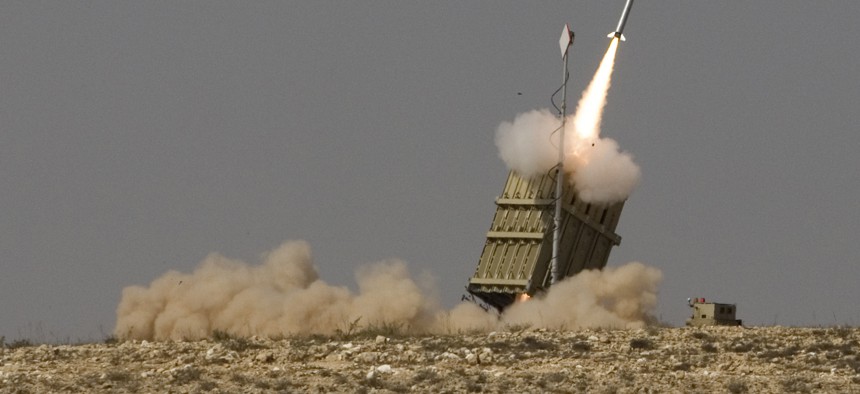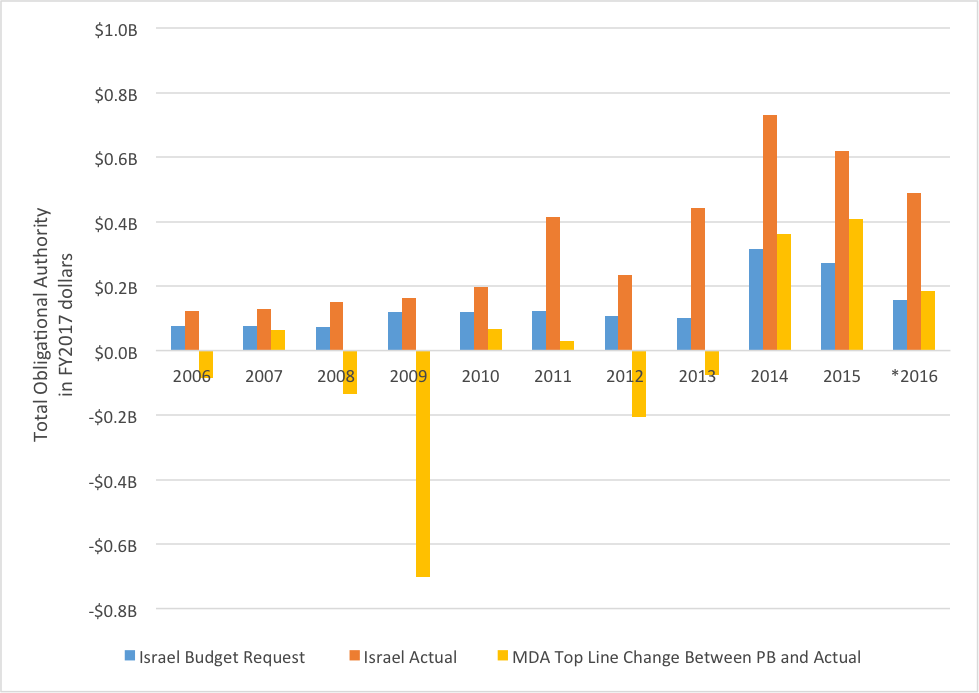
On Aug. 21, 2011, a rocket is launched from the Israeli anti-missile system known as Iron Dome to intercept a rocket fired by Palestinian militants from the Gaza Strip, in the southern city of Beersheba, Israel. AP / Dan Balilty
The Dirty Secret of US-Israel Missile Defense Cooperation
We need a way to fund Israel’s missile defenses without undercutting our own.
This weekend, the acting head of Israel’s National Security Council will visit Washington , reportedly to conclude a new multi-year aid package. Replacing an arrangement set to expire in 2018, the deal is expected to include hundreds of millions of dollars for Israeli missile defense efforts. But there is a problem that must be addressed before it undermines this important and valuable component of the countries’ alliance: In recent years, increased funding for Israeli missile defense has begun to directly compete with funding for U.S. missile defense efforts.
A bit of budgetary background: Aid for Israeli missile defense are drawn from the budget of the Defense Department’s Missile Defense Agency (MDA), even though it is more akin to foreign assistance. And when appropriators divert more money to the Israeli budget line, they almost invariably fail to fully compensate MDA. U.S. programs are then cut to pay the bill.
It’s the dirty secret of missile defense cooperation. Everybody knows this competition exists, but nobody wants to say so. And while MDA’s topline has been steadily falling for years, Israel’s numbers keep rising. Since 2009 alone, Congress has quadrupled U.S. financial contributions to Israeli missile defense. Between 2011-15, Israel received an average of 6.1 percent of MDA’s budget. In 2014, the figure was $729 million, or 9.1 percent.
A Kind of ‘Game’
For the better part of a decade, missile defense aid to Israel has followed an annual routine that goes something like this: First, the executive branch proposes a modest figure in its overall budget submission. Next, representatives and senators of both parties blame the executive branch for low-balling support for Israel, fire off press releases, and compete with one another for who gets to raise the level of assistance. After much-publicized amendments pass, everyone congratulates themselves for achieving “full funding,” measured not by the president’s request or any particular operational metric but by an amount informally requested by friends of Israel.

Israel Missile Defense Aid: Presidential Budget Requests, Congressional Additions, and MDA Top Line Adjustments, 2006-2017
The story repeated itself this year. Since March, a bipartisan group of 36 senators have signed a letter calling for $600 million in missile defense aid, four times more than the president’s $146 million request. This level has been embraced by both House and Senate appropriations committees.
Although U.S.-Israel missile defense cooperation spans decades, the real spike began with the 2011 conflict with Gaza. Even as Congress failed to reach a budget deal and instead passed the Budget Control Act, lawmakers appropriated supplemental funds to buy Iron Dome interceptors, marking the first time such funds went to procurement rather than R&D.
Related: US Ballistic Missile Defense Needs A Boost
Related: What North Korea’s Latest Missile Test Means for the US and Its Allies
Related: Why Turkey Chose, and Then Rejected, a Chinese Air-Defense Missile
Procurement funds have continued to rise ever since, even without an obvious need to replenish inventory, and now they cover the purchase of Stunner and Arrow interceptors as well. One may wonder just how many interceptors U.S. taxpayers need to buy for our Israeli friends. Earlier this year, the House defense bill directed DoD to clarify what, exactly, Israel’s interceptor inventory requirements actually are.
One U.S. senator has called all this a kind of “ game .” Everybody seems to benefit—except, too often, missile defense for defending the United States.
Needless Competition
This is not an argument against funding Israeli missile defense, which represents an important U.S. foreign and defense policy goal to help an ally facing serious rocket and missile threats, but rather to make sure it does not come at the expense of U.S. systems. On the merits, the level of support may even need to rise.
Such support has helped develop, produce, and field Israel’s multi-layered defenses, from the low-tier Iron Dome to the longer-range Arrow-3, so critical in the face of Iranian missiles and thousands of shorter-range rockets and mortars. Besides helping Israel sustain its qualitative military edge, the cooperation also helps the U.S. better understand realistic combat conditions and concepts of operation.
The level of funding for Israel is not the problem, but rather its competition with U.S. programs. In eight of the last 11 years, MDA’s topline was not raised to compensate for the congressional plus-up for Israel. In five years, the plus-ups came despite cuts, sometimes deep, to MDA’s topline. It’s begun to be a moral hazard.
Using U.S. missile defense programs as a billpayer for foreign assistance has had real effects. This years’ House appropriations defense bill, for instance, includes an additional $455 million supplement to reach the $600 million number, but only boosts the MDA top line by $296 million when compared to the President’s request. To make up most of the difference, House appropriators cut THAAD procurement by $39 million, and slashed some of MDA’s most critical R&D work, including $21 million from an already modest directed-energy effort, $30 million from a redesigned kill vehicle and booster for homeland missile defense, and $15 million for the next generation of multiple object kill vehicles .
One might suggest that appropriators are making these cuts to MDA programs on the merits, that they would happen irrespective of these plus-ups for Israel, and that the overall plus-up for Israel is fully covered. No one really believes this.
At the margin, it would appear that Israel missile defense is sometimes prioritized over and above U.S. missile defense dollars. For example, when the Bipartisan Budget Act of 2015 required DoD to cut $5 billion across the board, MDA’s share was $80 million. This resulted in major reductions to SM-3 and THAAD procurement. Israel missile defense funding, however, received no such haircut.
Possible Solutions
Some steps have already been taken to get a handle on the problem. A 2014 agreement with Israel and several past legislative provisions, for instance, require both co-production and technology sharing. Co-production may benefit American industry and, in turn, jobs and tax revenue, but it does not directly help U.S. missile defenses. More directly useful may be the transfer back to the U.S. of technologies developed with the help of the American taxpayer.
But the structure of funding needs reworking to avoid the perennial tension. One potential path forward is to recognize Israel missile defense assistance for what it is, a species of foreign assistance, and as such locate it in the State Department’s foreign military financing budget. If Israel missile defense should instead remain within DoD, however, appropriators might consider fencing or disaggregating U.S. programs more carefully. Not all missile defense is created equal.
News reports suggest that the new agreement negotiated by the Obama administration will attempt to create an agreed level of support, presumably with the understanding that friends of Israel will not lobby for fuller funding in the future. But a non-binding agreement alone will not guarantee self-restraint by friends of Israel from coming back next year and suggesting all over again that the agreed-upon level falls short.
The solution will not be easy or obvious. As with many problems, the responsibility ultimately falls on the shoulders of congressional appropriators. Whether by moving the funding to the State Department’s budget, fencing off U.S. programs, or some other means, the United States must ensure that critical missile defenses for the Israeli homeland do not come at the expense of critical missile defenses for the U.S. homeland and deployed forces abroad.





